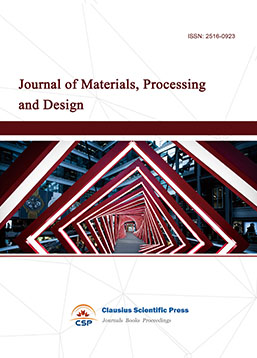Study on Aging of SBS Modified Asphalt Based on Temperature Sensitivity
DOI: 10.23977/analc.2024.030106 | Downloads: 26 | Views: 1443
Author(s)
Jingsheng Pan 1, Lisha Mu 1, Ping Li 1
Affiliation(s)
1 Department of Civil Engineering, Chengdu Technological University, Yibin, 644000, China
Corresponding Author
Ping LiABSTRACT
In order to explore the influence and variation law of SBS modified asphalt with different dosages on temperature stability under different aging times, a rotating thin film oven was used to simulate the aging process of asphalt. The softening point and ductility of SBS modified asphalt with different dosages were tested after aging for different durations. The softening point and ductility were used as indicators to evaluate the temperature stability of asphalt, and the variation law of softening point and ductility under different aging times was analyzed. The results indicate that with the increase of aging time, the overall ductility of SBS modified asphalt with different dosages shows a downward trend, and the softening point increases with the increase of aging time, and the change rates of the two indicators are completely opposite. Overall, the increase in aging time reduces the temperature stability of SBS modified asphalt.
KEYWORDS
SBS-Modified Asphalt, Aging, Temperature StabilityCITE THIS PAPER
Jingsheng Pan, Lisha Mu, Ping Li, Study on Aging of SBS Modified Asphalt Based on Temperature Sensitivity. Analytical Chemistry: A Journal (2024) Vol. 3: 30-35. DOI: http://dx.doi.org/10.23977/analc.2024.030106.
REFERENCES
[1] Wenhui Z, Jiuguang G, Mingyuan C, et al. Analysis of SBS content quantitative determination and rheological properties of aged modified asphalt binder. Construction and Building Materials, 2023, 403.
[2] Wei X, Yu L, Yaseen M, et al. MXene by regulating etching conditions enhanced UV resistance of SBS modified asphalt: Evaluating asphalt photo-oxidation and SBS degradation. Construction and Building Materials, 2023, 377.
[3] Guopeng Z, Aiqin S, Zhenghua L, et al. Research on anti-aging properties of POE/SBS compound-modified asphalt in high-altitude regions. Construction and Building Materials, 2023, 376.
[4] Surawattanasakul V, Sirikul W,S apbamrer R, et al. Perceived draught and odors: The key to SBS and indoor environment in hospital administrative offices - The AIRMED project. Building and Environment, 2024, 258.
[5] Hongjie H, Zhihui C, Peiliang C, et al. Rheological, chemical and short-term aging properties of waste polyurethane particles modified asphalt binder with or without SBS. Construction and Building Materials, 2022, 357.
[6] Shanglin S, Meichen L, Linbing W, et al. Effects of Different Natural Factors on Rheological Properties of SBS Modified Asphalt. Materials, 2022, 15 (16): 5628-5629.
[7] Yiqiu T, Junjie Z, Guilian Z, et al. Aging characterization of rheology and morphology evolution of SBS-modified asphalt. Construction and Building Materials, 2022, 342.
[8] Xu M, Zhang Y, Zhao P, et al. Study on aging behavior and prediction of SBS modified asphalt with various contents based on PCA and PLS analysis. Construction and Building Materials, 2020, 265.
[9] Zhang D, Zhang H, Shi C. Investigation of aging performance of SBS modified asphalt with various aging methods. Construction and Building Materials, 2017, 145, 445-451.
[10] Shuyan Z, Yanan C, Weiwei W. Low-temperature characteristics and microstructure of asphalt under complex aging conditions. Construction and Building Materials, 2021, 303.
[11] Zhang D, Zhang H, Zhu C. Effect of different rejuvenators on the properties of aged SBS modified asphalt. Petroleum Science and Technology, 2017, 35 (1): 72-78.
[12] Junwei L, Xia Y, Yongke Z, et al. Structure-performance evolution on thermal-oxidative aging of CeO;2;/SBS co-modified asphalt. International Journal of Pavement Engineering, 2023, 24 (2): 56.
| Downloads: | 1401 |
|---|---|
| Visits: | 81360 |
Sponsors, Associates, and Links
-
Forging and Forming

-
Composites and Nano Engineering

-
Journal of Materials, Processing and Design

-
Metallic foams

-
Smart Structures, Materials and Systems

-
Chemistry and Physics of Polymers

-
Modern Physical Chemistry Research

-
Inorganic Chemistry: A Journal

-
Organic Chemistry: A Journal

-
Progress in Materials Chemistry and Physics

-
Transactions on Industrial Catalysis

-
Fuels and Combustion

-
Casting, Welding and Solidification

-
Journal of Membrane Technology

-
Journal of Heat Treatment and Surface Engineering

-
Trends in Biochemical Engineering

-
Ceramic and Glass Technology

-
Transactions on Metals and Alloys

-
High Performance Structures and Materials

-
Rheology Letters

-
Plasticity Frontiers

-
Corrosion and Wear of Materials

-
Fluids, Heat and Mass Transfer

-
International Journal of Geochemistry

-
Diamond and Carbon Materials

-
Advances in Magnetism and Magnetic Materials

-
Advances in Fuel Cell

-
Journal of Biomaterials and Biomechanics


 Download as PDF
Download as PDF